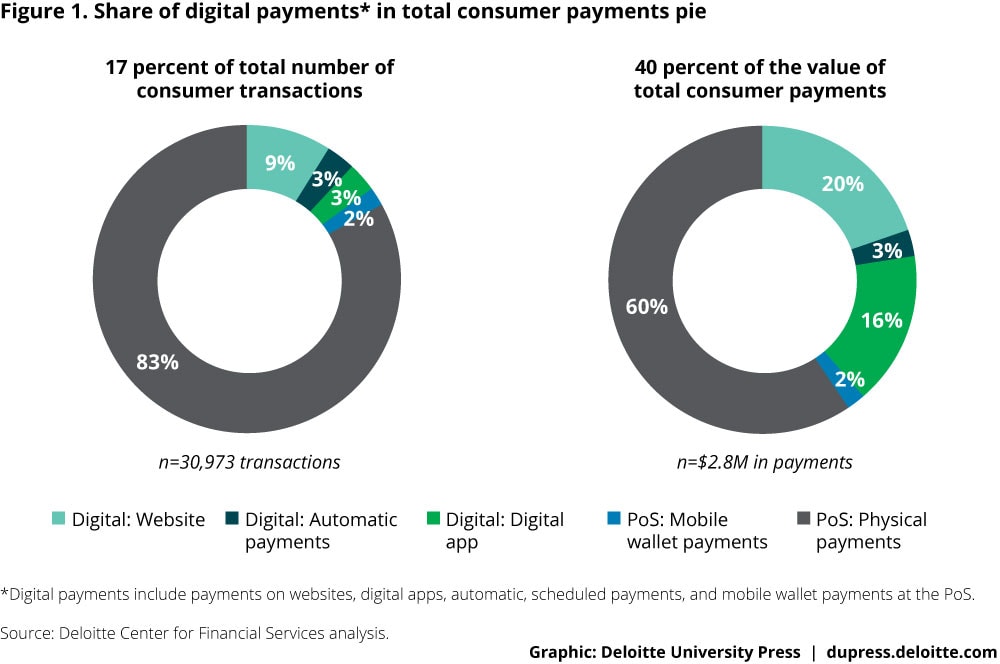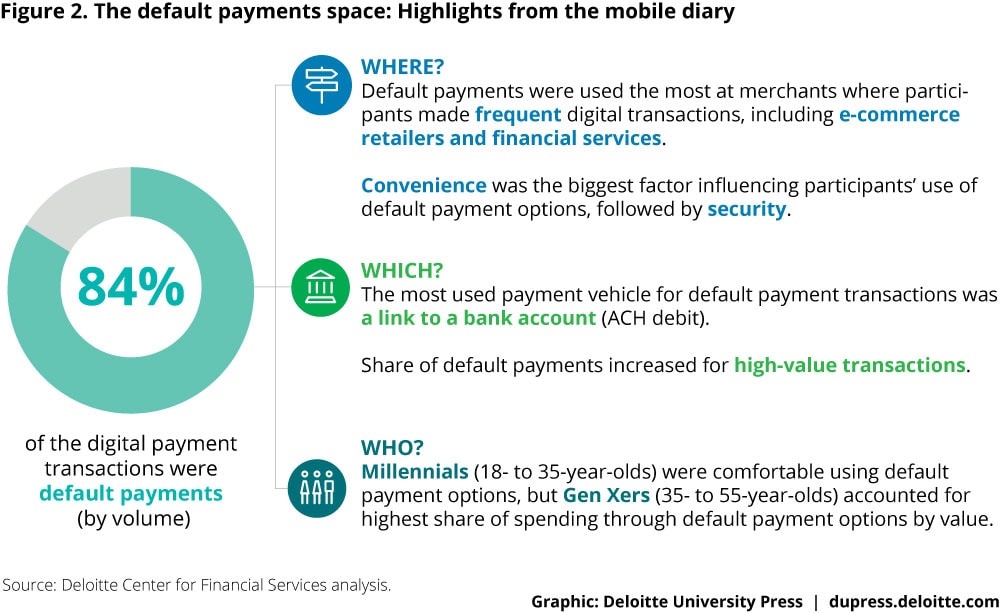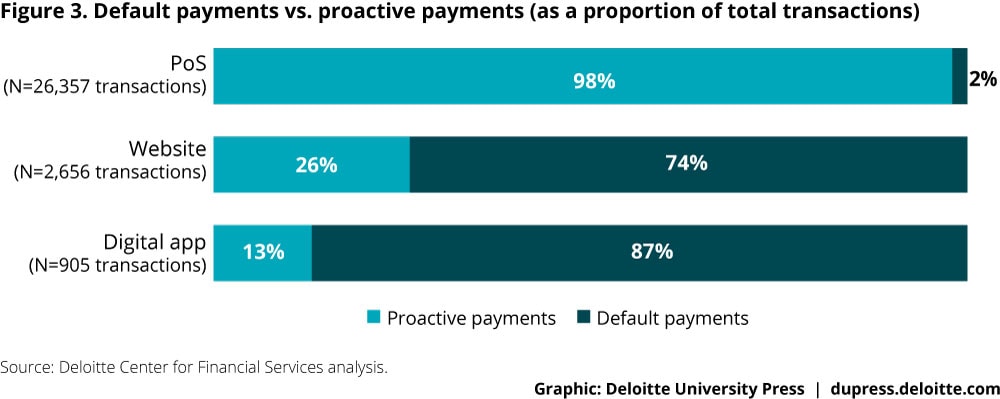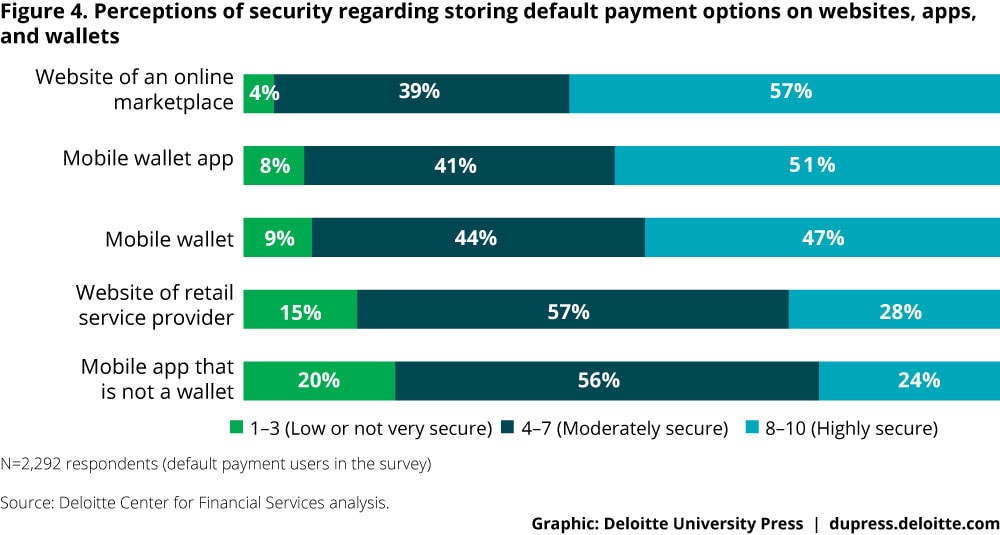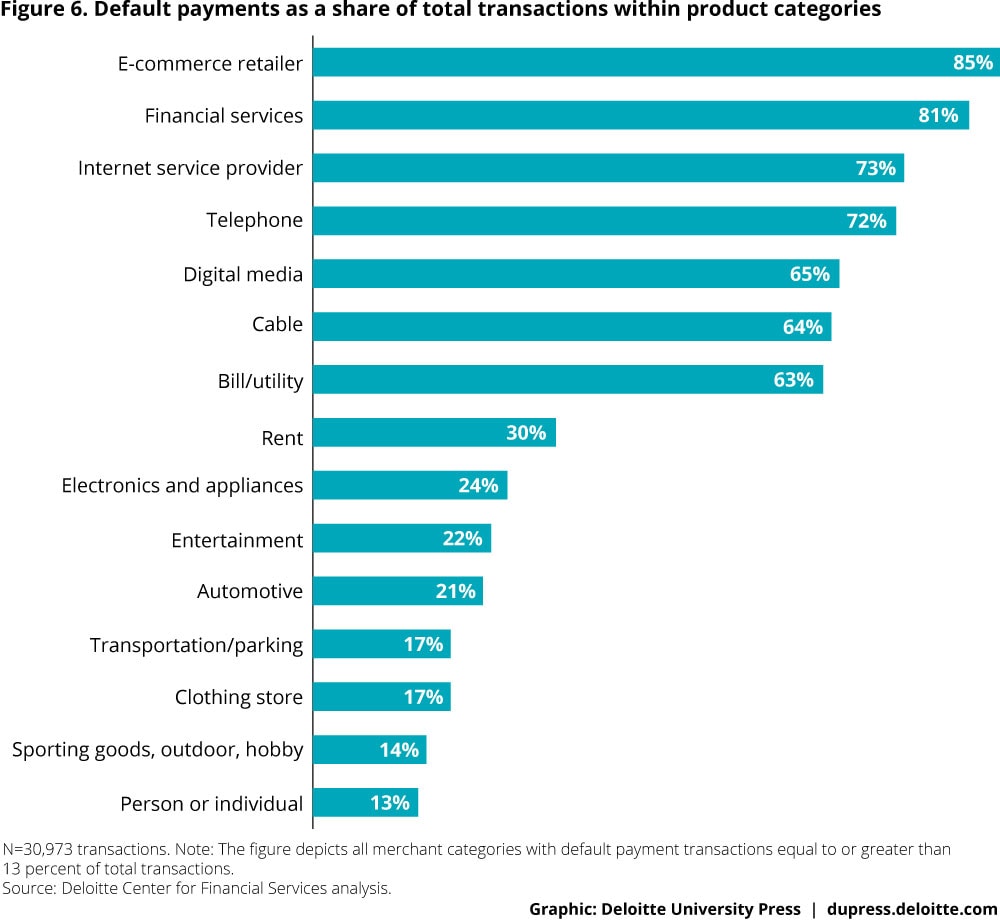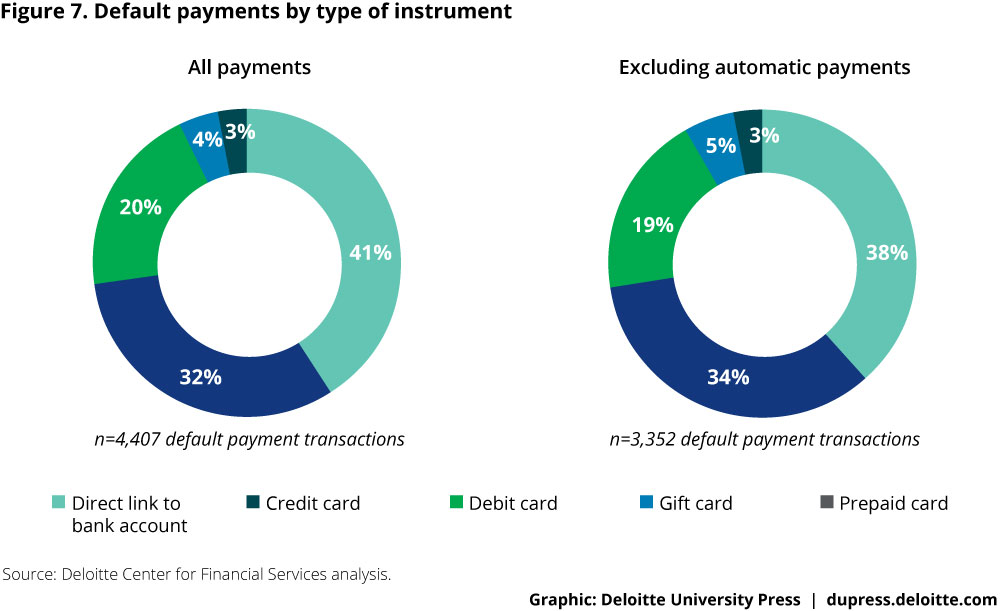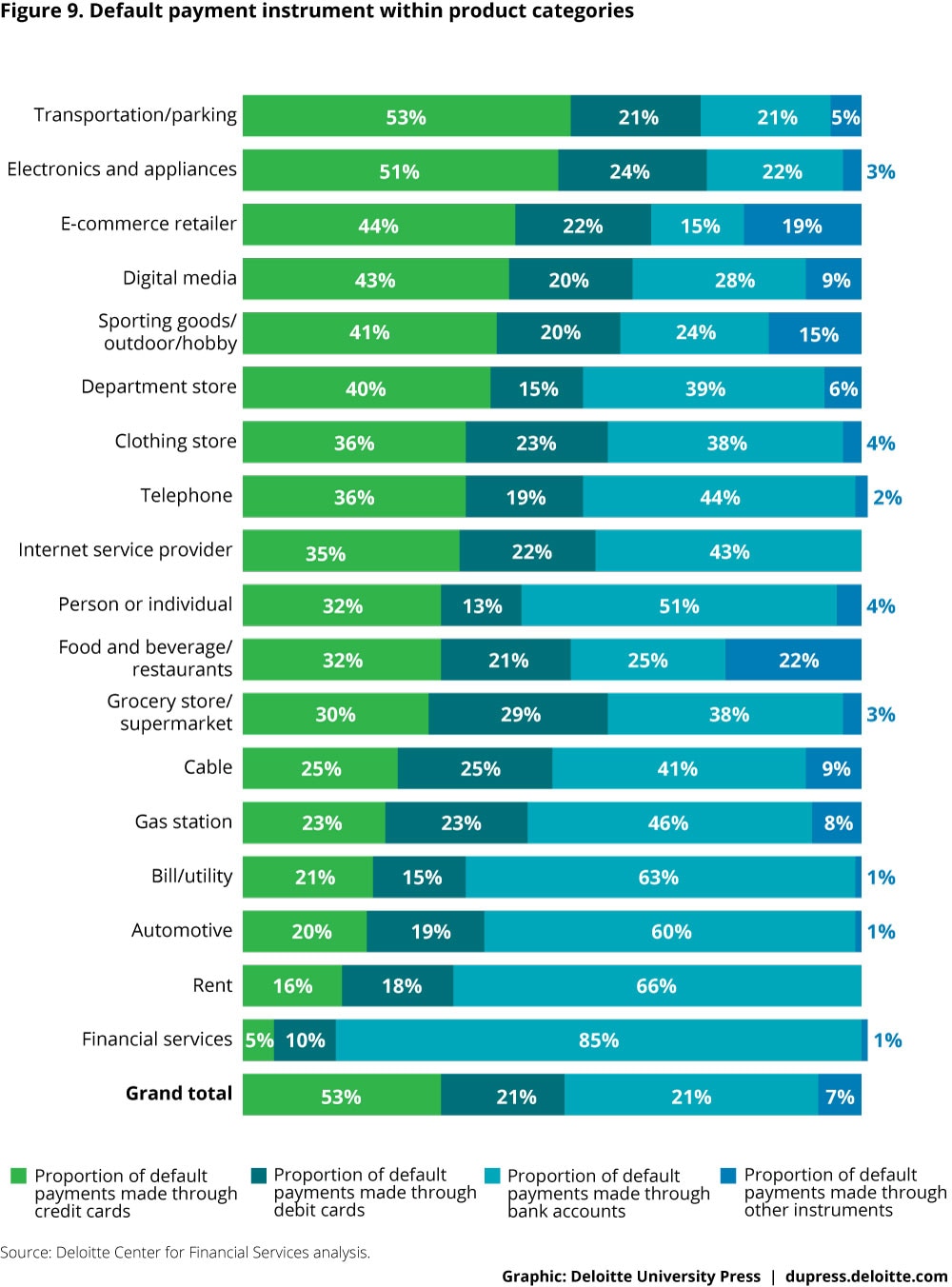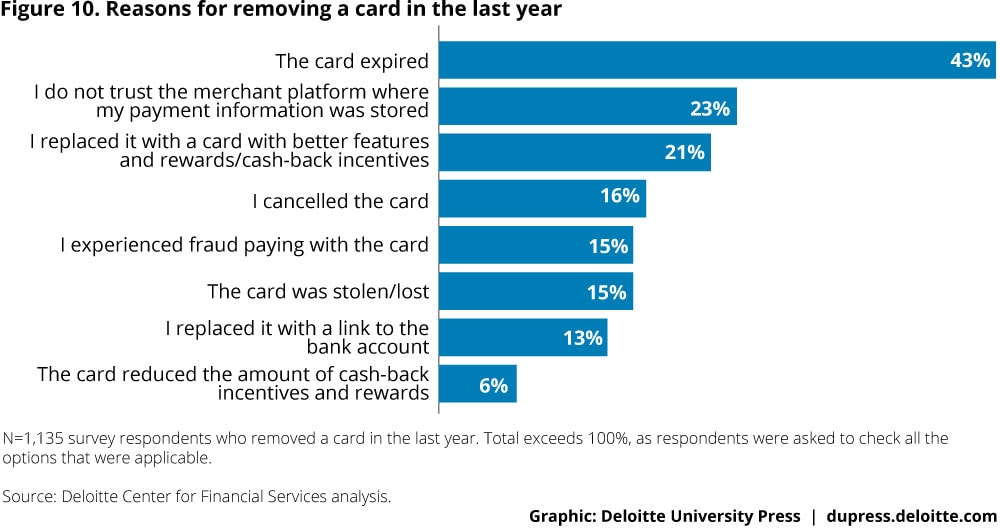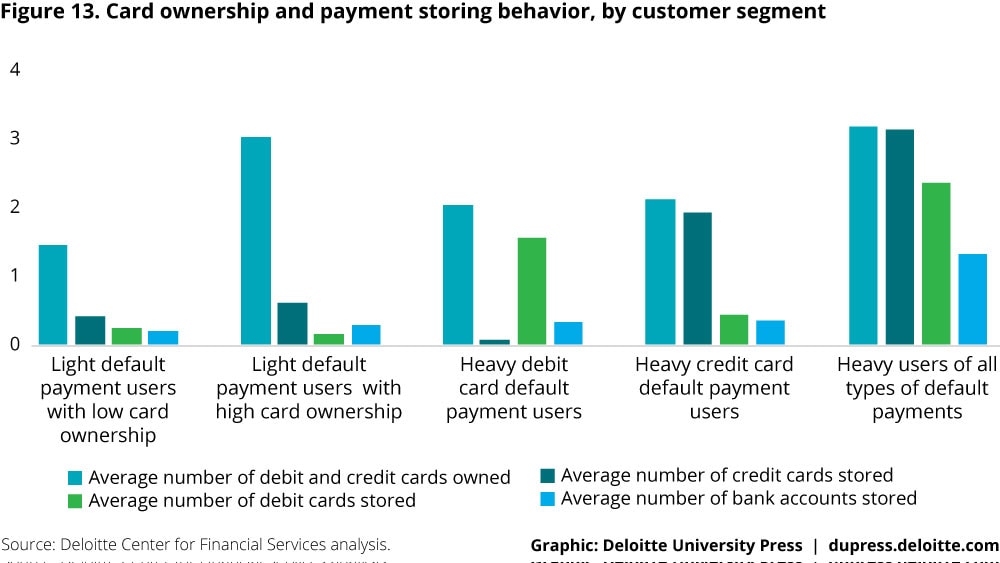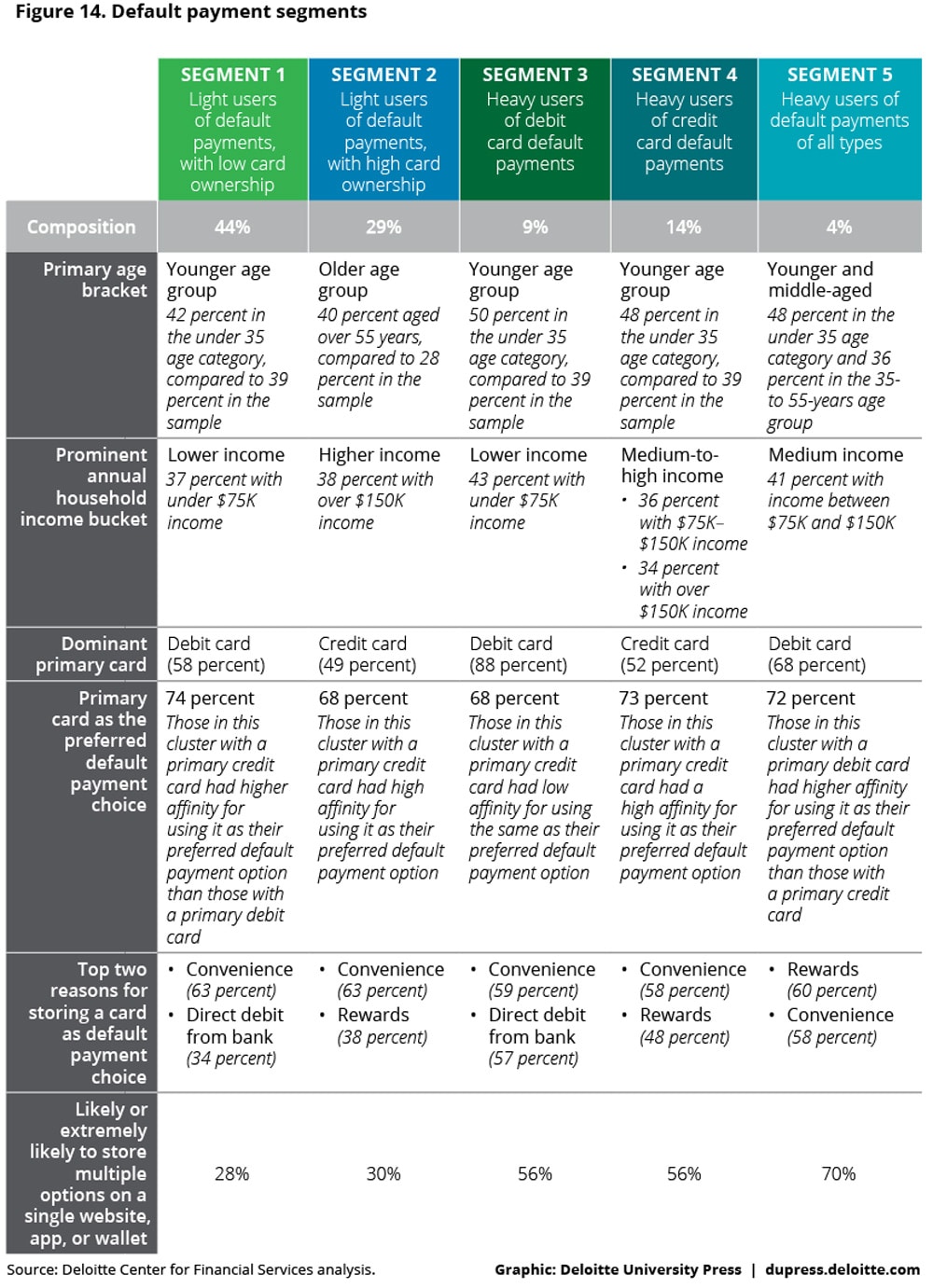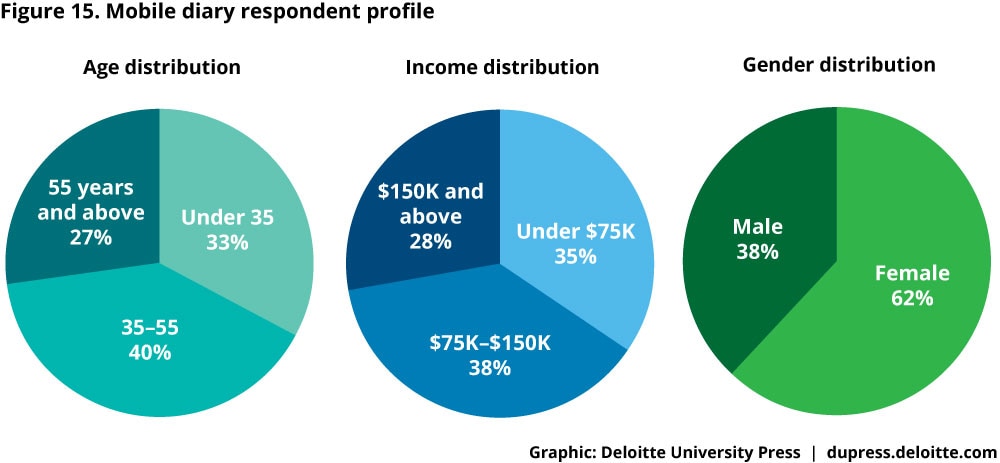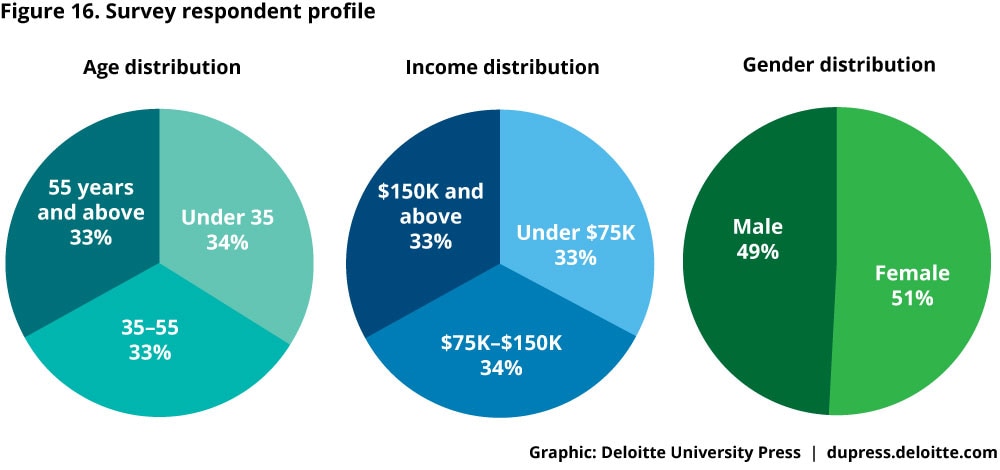“Default” payment methods has been saved

“Default” payment methods The digital marketplace reset you did not see coming!
21 October 2016
In the path to checkout, many consumers are increasingly demanding simple, secure, and beneficial options. They’re opting for just a few preferred payment methods to make those transactions. So how can FSI firms ensure their products secure a “top of wallet” spot and become a go-to choice?
The growing phenomenon of default payments
How consumers pay for things has always kept pace with new technologies. But the recent growth of digital commerce is transforming consumer payments like never before. Although it only accounts for 8 percent of retail sales today, e-commerce is growing at a faster clip than other channels, and is expected to reach $0.5 trillion by 2018.1 The growth of mobile commerce is even more impressive, forecast to almost double by 2020, reaching $242 billion.2
This growth in digital commerce, along with the shift to digital payments, is influencing how consumers pay for what they buy. In particular, a consumer behavior dynamic we call “default payments”—payments made with credit card, debit card, and bank account payment details that have been stored for ongoing and future transactions—is taking root in unexpected ways. We believe this trend can have a significant impact on card issuers and retailers alike.
To better understand this default payment behavior, the Deloitte Center for Financial Services conducted a novel study that drew results from two primary research efforts. First, we deployed a “mobile diary” that tracked nearly 31,000 payment transactions over a one-month period, followed by a 3,000-respondent survey, which queried respondents on their perceptions, decision making, and future payment behaviors. (See appendix for more details on the methodology.)
With the results of our mobile diary and survey, we answer three fundamental questions:
- Where are consumers most likely to use default payment options—and are there ways in which issuers can participate in these marketplaces?
- Which type of default payment option is preferred, and what causes this preference to shift?
- Who is most likely to embrace default payments, and why?
Broadly, our study confirmed that default payments are already the dominant mode of payment in digital transactions, used extensively in online shopping, with mobile apps, and with mobile wallets at the physical point-of-sale (PoS) terminal. Our mobile diary participants made 84 percent of their digital payments using default payment options.
We consider default payments behavior as both an opportunity and a threat to incumbent payment providers. Not every card that a consumer holds is destined to be a default payment choice. The default payment users in our survey confirmed this, as they reported owning an average of 2.8 credit cards, but used only one credit card on average as their default payment option on online marketplace websites.
Hence, the opportunity for card issuers is that once they establish their cards as default payments in a “digital wallet,” they compete with a smaller pool of cards, and their cards have a higher probability of being used. Of course, those who are left out of these “digital wallets” may lose market share; however, our study also reveals that, at least in the foreseeable future, there are still opportunities to acquire customers for default payments.
As such, we expect heated competition to win the top of customers’ digital wallet position. If customers end up paying with one default payment instrument more often than others, the implications on payment provider incumbents may be significant. Thus, not only must incumbents secure a default payment position, but they must also compete to be the customers’ preferred payment choice.
To win the top-of-digital-wallet position, card issuers will likely have to employ creative strategies to influence consumer behavior. In particular, partnerships between card issuers and retailers will likely increase, and new value exchanges among all transactional parties may have to be forged.
Discretionary vs. nondiscretionary default payments
Digital payments, according to transactions tracked through our mobile diary (on websites, mobile apps, automatic payments, and in-person, point-of-sale payments using mobile wallets) accounted for 17 percent of total consumer transactions and 40 percent of the value of total consumer payments (figure 1).
Default payment behavior is often a pivotal element of digital transactions. As noted previously, 84 percent, by number, of digital transactions were default payments, which accounted for 87 percent of digital transactions by value.
Seventy percent of the default payments in our mobile diary could be considered discretionary payments, those for which customers have more budgetary discretion to make, depending on their cash flow and credit appetite. Such payments were predominantly made on websites, and particularly on online marketplace websites. The discretionary component of default payments may be the focus of default payments expansion, affirmed by the general direction in which digital payments have already been moving.
On the other side of the coin, roughly 30 percent of the number of default payment transactions tracked could be considered payments that are nondiscretionary, meaning payments that are ongoing, fixed parts of a customer’s budget, such as electricity bills and mortgage payments. (We erred on the side of conservative and added cable and Internet service provider bills to this list.) For these types of payments, the Automated Clearing House (ACH) default was most used as the payment instrument (more on this later), and we believe there is less thought given to change these default payment options once they have been stored.
We believe it is worth making this distinction between discretionary and nondiscretionary payments to suggest that payment providers differentiate their acquisition and retention strategies accordingly. The ability of issuers to be top-of-wallet in both of these types of spending seems essential for competitive advantage. And paradoxically, recognizing and identifying the inertia related to default payment behavior, especially inherent in nondiscretionary spending, seems equally important in that dislodging a default payment choice may be no easy task.
Cracking the code of default payment behavior
As stated earlier, we lay our foundation to analyze and comprehend the direction of default payments behavior with three main questions (figure 2).
Where are default payment choices used?
In line with e-commerce being a driver for default payments, our mobile diary results showed three quarters (by number of transactions) of total payments on websites were made using default payment options. The proportion of default payments of total consumer payments was even higher for in-app payments (see figure 3).
In addition, the merging of the digital world with the physical world is likely to increasingly influence the growth of default payments. Digital influence—the use of digital devices for searching, shopping, and payments during in-store purchases—has increased substantially with the ubiquity of mobile phones.3 Smartphones influenced $1.4 trillion of in-store sales in 2015, compared to a mere $160 billion in 2012.4 And, with the growing use of mobile wallets, digital influence on purchasing behavior will likely only continue to rise.
However, as figure 3 shows, only 2 percent of in-person, PoS transactions in our mobile diary involved default payments, which encompass the nascent market of mobile wallet transactions. Obviously, mobile wallets are yet to gain ground among the masses, but we fully expect their use to increase—one-third of default payment users in our survey reported being likely or extremely likely to increase storing default payment options on mobile wallets in two years’ time.
Recognizing this potential, multiple stakeholders in the payments industry are developing mobile wallet strategies. In 2015, JPMorgan Chase announced it will launch its Chase Pay mobile wallet5 to compete with existing digital wallets, including Apple PayTM and Samsung Pay. The bank intends to overcome their competitors’ head start by leveraging their customer base to start out its digital wallet offering with scale. The wallet will be available to the bank’s 94 million active credit, debit, and prepaid card accounts.6 Meanwhile, the Chase Pay wallet is attracting merchant partners that are drawn to its lower-cost transaction model with no fraud liability.7 Another interesting feature of this wallet is its integration of the participating merchants’ loyalty programs into its app.8
That said, payment providers should be aware of which factors make customers comfortable with default payment options on these websites, mobile apps, and mobile wallets.
I would prefer to store my payment details for the convenience instead of having to look up the card number all of the time, but I would probably only do it with secure sites that are for sure secure, and those are few and far between nowadays.— A mobile diary participant
When asked their primary reason for using a default payment for a transaction, 47 percent of our diary participants cited convenience, and about 17 percent cited trust in the payment provider. However, operating under the logic that security enables the storing of payment details digitally in the first place, we probed the security issue deeper in the survey. For one, our survey results indicate that online marketplaces have nearly mastered the task of ensuring customers’ comfort level with storing payment options on their websites, as only 4 percent of default payment users regarded this platform as “not very secure” (figure 4). As testament to its importance in this market, Amazon, a leading online marketplace, is developing a facial recognition technology to authenticate shoppers’ identities to reduce online fraud.9 Yet this brand is already strong enough in the default payment category that its Echo customers are comfortable giving the built-in “Alexa” app voice commands to order purchases without her asking what payment card or bank account to use. Meanwhile, websites of retail service providers—merchants that also have a physical presence—attracted a high security rating only from approximately one-quarter of default payment respondents.
As figure 4 shows, mobile apps, which differ from mobile wallets, also have work to do in the security area. An example of a mobile app providing payment services would be applications on smartphones that perform person-to-person payments or ordering and payment links to restaurants for pickups or deliveries. A sizable 28 percent of the over 55 year-old segment view mobile apps as risky for storing default payment options, which we believe could be largely because this age cohort may be unfamiliar with them; only 16 percent of the youngest age cohort rated mobile apps as risky.
In line with current trends, our survey finds that the likelihood of using default payments on e-commerce sites and mobile apps/wallets is only expected to increase in the next two years (figure 5). Interestingly, there were no significant differences by age or income brackets across any of the platforms, be it websites, mobile apps, or mobile wallets.
There were no significant differences by age or income brackets across any of the platforms, be it websites, mobile apps, or mobile wallets.
Shifting the focus to the merchants where customers use default payments, our mobile diary participants used default payments overwhelmingly for e-commerce and financial services transactions, which encompassed both discretionary and nondiscretionary payments, respectively. As expected, discretionary is dominant, and we expect it to increase. On the nondiscretionary end, one-third or more of recurring transactions were related to utilities, including Internet service providers and telephone service (figure 6).
Which type of default payment option is preferred, and what causes this preference to shift?
Bank accounts were the most used default payment choice when viewed through the total default payments lens, and not just for automatic, nondiscretionary payments (see sidebar, “But what about automatic payments?”); 41 percent of default payment transactions were made through a link to a bank account (figure 7). In fact, the number is more eye-catching when viewed from a transaction value perspective: More than one-half of the default payments by value were made using bank accounts. Again, convenience was cited as the most important reason for choosing bank accounts in 55 percent of such transactions, followed by trust in the bank and its security (29 percent of transactions).
Credit and debit cards ranked as the second and third most-used default payment instruments, respectively. Credit cards were used for one-third of default payment transactions by both number and value of transactions. And the overwhelming reason why customers use credit cards as default payments was rewards. Customers cited attractive rewards, cash back incentives, and discounts as the top reasons for their card selection for two in three credit card-based default payments. Debit cards, on the other hand, comprising 20 percent of default payments by number and 10 percent by value, were mostly chosen because of their link to the respective bank accounts (46 percent).
Interestingly, stripping out the automatic, recurring default payments did not change the picture significantly (figure 7).
BUT WHAT ABOUT AUTOMATIC PAYMENTS?
A logical question to ask is how many default payments are made automatically on a recurring basis, such as mortgage payments and electricity bills. Our survey revealed that automatically scheduled payments comprised a sizable 24 percent of default payments (figure 8). Because we tagged each payment to a merchant/recipient category, we could delineate which of these were recurring automatic payments vs. discretionary, nonrecurring payments.

So while automatic payments surely will continue to play a role in the default payment landscape, they will likely remain the smaller part of the pie. The platforms on which most of the current default payment users in our survey are likely or extremely likely to increase default payments in the next two years are online marketplaces, such as Amazon (50 percent), which garner a higher share of nonautomatic consumer payments.
A closer look at the merchants or recipients of such payments, however, revealed interesting differences regarding which preferred payment instruments (figure 9) consumers used for particular merchant and service provider categories. For recurring payment categories, such as mortgages or insurance premiums, rent, bills, and utility transactions, they preferred using ACH debit. But credit cards were used most for discretionary spending, such as payments made for e-commerce purchases, digital media, entertainment, department stores, and even parking.
In the survey, we found that among this credit card market share, retaining the default payment spot in customers’ digital wallets is as important as acquiring it. Our survey showed that 50 percent of default payment users removed a card stored on one or more websites, apps, or mobile wallets in the last year. Predictably, concern about security plays a role when consumers decide not to use a particular card for default payments anymore; 38 percent of the default payment users in our broader survey who removed a card did so because they lost trust in the website or app in which the card was stored, or they experienced fraudulent activity while paying with the card (figure 10).
But as figure 10 demonstrates, the main reason cited for changing a default payment choice, according to our survey, was card expiration. More than 40 percent of survey respondents who removed cards as default payments cited expiration of their card as the reason for removal. Therefore, expiration date becomes a crucial moment of truth for payment providers; they need to step in and/or influence the customer’s default payment choice—both for customer acquisition and retention.
Rewards and better features also played a prominent role in whether a customer decides to switch their default payment card. One-fifth of the survey respondents who removed a card switched to another card that offered better features or rewards. This card switching behavior has serious market share implications. For example, the total size of the card payments pie could shrink if customers increasingly replace cards with ACH debit payments. About 13 percent of default payment users who removed a default payment card in the survey replaced it with a direct link to a bank account. As our study indicates, default payments by ACH debit are expanding beyond nondiscretionary, recurring payments. The shift to ACH debit could accelerate if merchants, such as online marketplace retailers, aggressively encourage their customers to use a default payment option that links directly to a bank account, to improve their retail margins by replacing credit card interchange fees with the lower cost of ACH debit transactions.
Another tactical area in which payment providers may wish to target their strategies is around the frequency and levels of transactions (regarding the former, see sidebar, “Default payments in ride-sharing apps”). Our mobile diary participants used default payments across a wide spectrum of transaction values—for transactions as low as $5 to those in the thousands of dollars. Predictably, lower-ticket purchases (up to $50) were much greater in number, so the number of default payments was highest in transactions valued between $10 and $50. However, a closer look at the proportion of payments for different transaction sizes revealed that the diary participants did not hesitate to use stored default payments for high-value payments—in fact, they used them more often.
Instinctively, it would be easy to argue that these higher-value transactions would be automatic payments, but this was not the case. In absolute terms, it was true that large default payments tended to be automatic. But when we stripped out automatic payments, the trend remains (figure 11)—the share of default payments still shows a similar upward trend as a proportion of high-value transactions for merchant categories such as financial services, automotive, and hardware purchases.
Default payments in ride-sharing apps
In Singapore and five other Southeast Asian countries, Citigroup is partnering with Grab, a ride-sharing app, to allow the bank’s credit card customers to redeem their reward points as payment for the car service.10 The collaboration is part of a broader strategy to tap into customers’ frequent purchases—in this case, their everyday transport—vs. targeting their one-off retail purchases.
Targeting frequent payments appears to be a logical strategy, as it could make payment choices stickier, leaving little scope for change unless the customer experiences something exceptionally off-putting.
Who is most likely to embrace default payments, and why?
Given the common perception that Millennials are most comfortable with, and the most avid users of, the latest digital technology, we expected them to be the top contenders for digital payment market share. Our mobile diary revealed that Millennials as well as Gen Xers were more comfortable using default payment choices on digital platforms than were older respondents (those 55+ years old).
However, by value, default payments comprised 39 percent of the payments transactions made by Gen X participants—the largest share among all age groups, and notably higher than the younger (32 percent) and older respondents (29 percent). Although Millennials are commonly thought to be the most digitally savvy age cohort, Gen Xers have grown up on the Internet, where most default payments are still happening, and have generally higher incomes and more advanced financial obligations than Millennials; hence, this result was not too surprising.
We referred to the broader survey results to delve deeper into the behavioral and attitudinal differences across groups. Here, we learned that nearly one in four survey respondents did not use stored default payments at all. A closer look at this segment revealed that it was skewed toward older respondents.  Nearly one-half of the non-users of default payments were over 55 years old, and only 19 percent were under 35 years old. Meanwhile, security was cited as the biggest inhibitor to using a default payment option (57 percent).
Nearly one-half of the non-users of default payments were over 55 years old, and only 19 percent were under 35 years old. Meanwhile, security was cited as the biggest inhibitor to using a default payment option (57 percent).
To better understand the differences across groups, we performed a segmentation analysis of participants’ default payment type storing behavior. This exercise yielded five mutually exclusive clusters. Figure 12 highlights the composition of default payment users and figure 13 maps the differences among each segment. Figure 14 adds color to the segments’ differences; our objective in conducting this cluster analysis was to spur meaningful discussion around how to target these customer segments.
What’s next for stakeholders in the payments ecosystem?
As our study reveals, the growth in default payments will necessitate a new set of strategies for card issuers. This consumer behavior dynamic that is already so prevalent in digital transactions introduces fresh challenges, and no doubt, some potential opportunities. The main questions to address are which actions card issuers can take to win and retain the default position for digital payments in the current context, and also to grow and capture future digital default payments. More specifically:
- Which incentives can be offered, and how could the benefits of default payments best be communicated to the customer (for example, security features)?
- What preemptive actions can be taken (for example, facilitating the updating of stored default payment information when cards are replaced/renewed) to prevent switching to another default payment choice?
- What strategies can be implemented to convince existing card holders to switch their default payment options from competitor cards?
- How can cards defend their default payment market share from moving to bank account-linked default payments?
- On the other hand, can the nondiscretionary default payment spend that currently goes through bank accounts be targeted by partnering with utility companies to offer signup incentives?
- What opportunities exist to increase the use of mobile wallets and apps for POS transactions (for example, better communication of security and convenience)?
- How can banks use partnerships with merchants and/or digital marketplaces that would position banks to capture/influence customer wallet share and/or extend and enhance the customer experience; what would be the best strategies to identify the most appropriate partnerships?
- As the secular move away from cash toward digital payment accelerates, can merchants/other alternative payment providers disintermediate the banks in the payment process; what steps should banks take to understand and address this possibility?
Playing the default payments game
In this report, we highlighted the increasingly prevalent consumer behavior of using default payments. We quantified this phenomenon through a novel approach—using a mobile diary study along with a cross-section survey.
We also presented the case for why payment providers should take notice of default payment behavior, and, more importantly, offered some key questions and strategies for consideration.
In our view, it is not a question of whether default payments will alter the fortunes of payment providers in the future, but how soon. The acceleration of digital commerce and the merging of the physical world with the digital world will likely all but ensure that default payments will become the norm in the future.
Now is an opportune time for card issuers, payment providers, and retailers to develop strategies that take advantage of default payment behavior, and become the “top-of-wallet” choice. The good news is that firms can influence these choices in a variety of ways throughout the consumer lifecycle—from acquisition to retention. But it would also behoove providers to be mindful of customers’ concerns, especially related to security.
The rewards of such strategies are plain to see: happier customers, higher revenues, and greater market share, even as the payments landscape undergoes significant shifts.
Appendix
Methodology
We worked with MFour, a market research firm, on two primary research instruments. The first instrument was a unique consumer payments mobile diary study of 1,091 participants split into two waves, with each wave recording transaction entries for over a period of 14 days. The participants recorded 30,973 real-time and near real-time payment transactions in total.
We buttressed these results by conducting a one-time survey of 3,000 customers to identify spending trends, perceptions, attitudes, and behaviors related to overall payment behaviors, digital shopping, and in particular, default payment choices. The mobile diary and the survey samples have not been weighted to reflect US population demographics.



